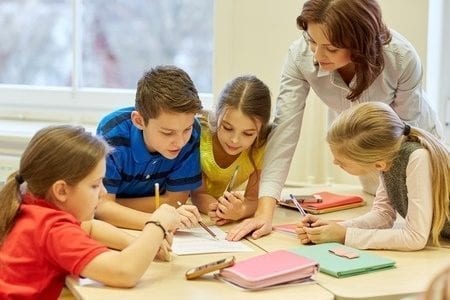Emphasize Flexibility and Adaptability When Grouping Students
The gifted group. The slow group. The behavioral issues group. Grouping in schools fell out of favor partially because educators—and parents—felt like kids were getting labeled and that groupings didn’t help students improve. While not calling for a return to those rigid structures, in the edWebinar “Flexible Grouping and Collaborative Learning: Making It Work,” Dina Brulles, Ph.D., and Karen L. Brown, M.Ed., both education consultants, advocated for using groups to assist student learning. They discussed how adjusting student combinations, adapting teaching methods, and preparing students for group learning can lead to successful outcomes.
- Base groupings on information: Use pre-tests, formatives assessments, learning styles, and even student interest surveys to divvy up the students. Align the educational needs and passions of students to make sure that students within the groups have a shared goal.
- Keep groupings flexible: Students should not be in permanent groups with the same set of students for even a semester, much less the school year. Teachers should create groups for a specific learning goal or project and then reassess for the next lesson. This helps students avoid labels and learn to work with all of their peers.
- Don’t assess and forget: For groupings based on ability or readiness, don’t just plop the kids together and assume they’re all set. Keep gathering data. If grouping is based on readiness to learn multiplication, for example, keep track of student progress. Based on assessments, you might find that some students need to change groups in the middle of the unit.
- Use a variety of assessments: Not all evaluations need to be formal pencil-and-paper or computer-assisted exams. They can be as simple as talking with students and discussing where they are with the lessons. Using different methods of assessment, teachers can get a clearer picture of student mastery and abilities.
- Adapt teaching methods for the different groups: One of the biggest mistakes is putting students in groups and then assigning them all the same goals, giving them the same work, and using the same teaching methods for each one. For instance, one group might need constant prompts and direction instruction while another is set with a learning goal and list of resources. There’s no point in grouping the kids if they aren’t getting differentiated instruction.
- Teach students how to work in groups: Whether the students are staying in their seats and need to learn how to stay on task or moving from station to station, they’ll need to have clear expectations for their group learning. Many teachers practice how to work in groups—listening, using quiet voices, following the pattern of the stations, etc.—before they assign group work. This allows the teacher to focus on the learning goals and not behavior.
When teachers decide to start flexible grouping, the presenters advised that they start small. They should pick their strongest subject or the most adaptable project. More important, they need to make sure the parents understand and support the group learning.
“This is a different system then what they went to school with, so it’s frightening for them,” said Brown, “‘What do you mean you’re grouping kids, and you have kids doing different things at different times?’ It’s okay. But you need to talk with parents and help them understand that this way I know exactly what your child needs. I’m going to provide a targeted instruction to meet that child’s needs, and then I’m going to assess based on that targeted instruction so I know whether your child is ready to move forward.”
This edWeb broadcast was sponsored by Free Spirit Publishing.
This article was modified and published by eSchool News.
About the Presenters
Dina Brulles, Ph.D. is a school administrator and the gifted-education director for Arizona’s Paradise Valley Unified School District. Recognized for her expertise in creating and supervising schoolwide cluster grouping, she also assists districts throughout the United States in developing gifted-education programs, including those districts serving culturally and linguistically diverse gifted students. She holds a Ph.D. in gifted education and an M.S. in curriculum and instruction and serves on the faculty of the Graduate College of Education at Arizona State University. Dina coauthored the books: A Teacher’s Guide to Flexible Grouping and Collaborative Learning; Designing Gifted Education Programs: From Purpose to Implementation; Differentiated Lessons for All Learners; The Cluster Grouping Handbook; Teaching Gifted Kids in Today’s Classrooms; and Helping All Gifted Children Learn. Prior to becoming an administrator, Dina was an elementary classroom teacher, a bilingual teacher, an ESL teacher, and a gifted-cluster teacher. She lives in Peoria, Arizona.
Karen Brown, M.Ed. is the gifted program mentor for Arizona’s Paradise Valley Schools. Karen works with K–12 teachers to ensure that the instruction provides the appropriate challenge for all students. Karen teaches in the gifted education master’s program at Arizona State University and consults throughout the country. Karen is the recipient of 2018 NAGC Master’s and Specialist Award and was the co-recipient of the 2013 NAGC Professional Development Award. She has coauthored two books: Differentiated Lessons for Every Learner and A Teacher’s Guide to Flexible Grouping and Collaborative Learning.
Join the Community
Social-Emotional Learning, Positive Behavior, and Student Achievement is a free professional learning community on edWeb.net that offers a place for educators to explore practical, effective ways to integrate social-emotional learning, inclusive teaching practice, and higher-level instruction.






Comments are closed.